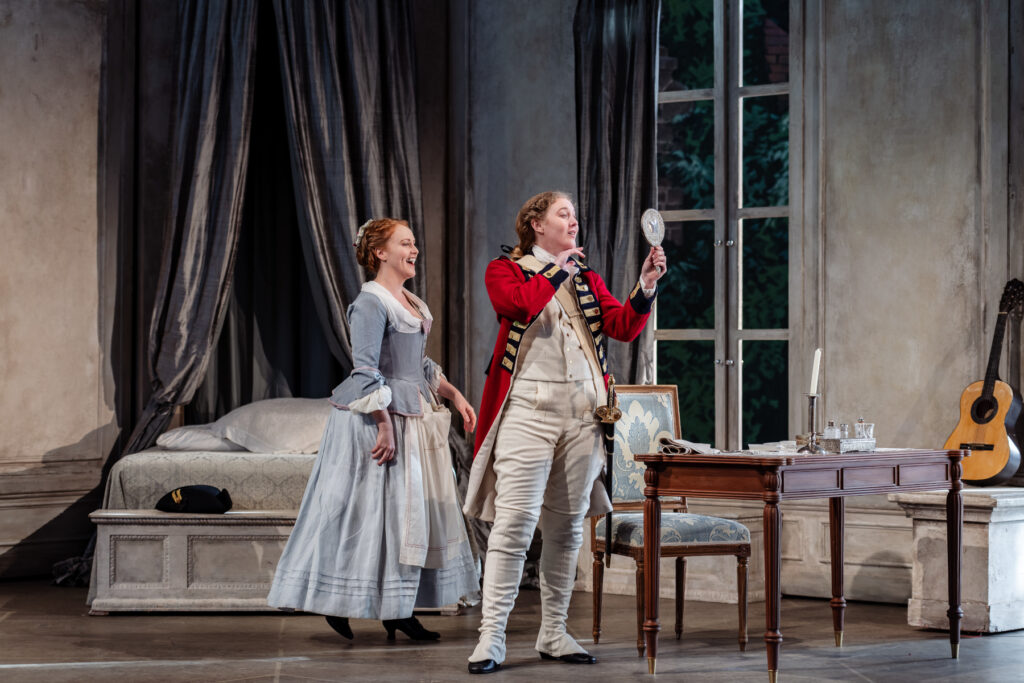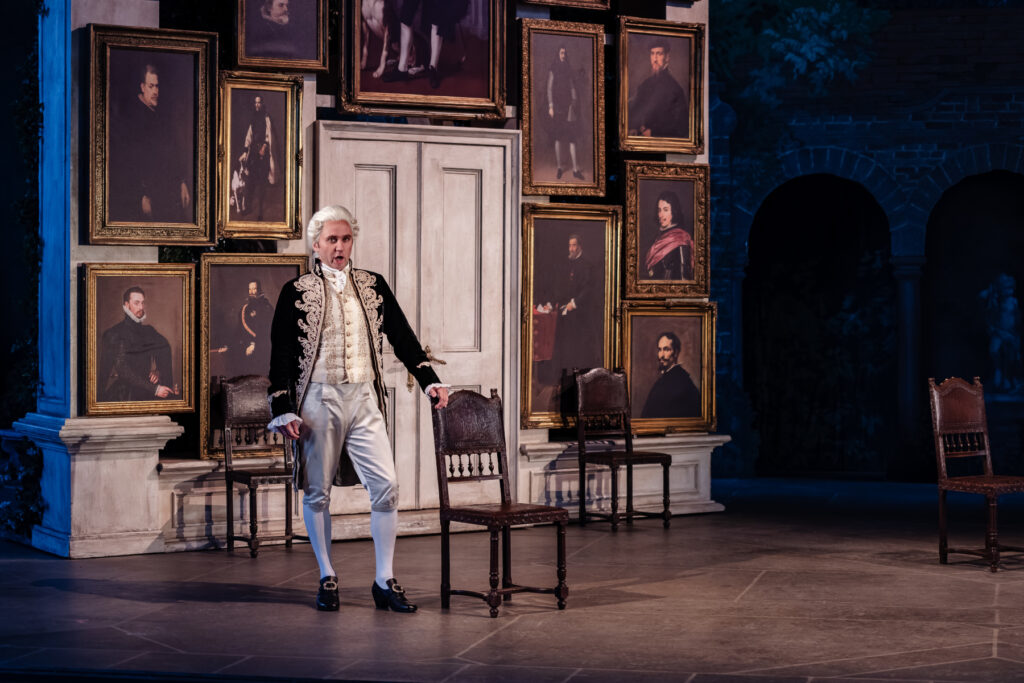In some senses this Figaro is a throwback. John Cox’s staging was first seen in 2005, when Garsington Opera still made its home in the gardens of Garsington Manor in Oxfordshire. The company moved to the vast, rolling Wormsley Estate in Buckinghamshire in 2011 and revived the production in its purpose-built ‘opera pavilion’ six years later. Over the past two decades directorial styles and fashions have changed and Cox, now 89, belongs to a different era. A Figaro such as his, set unquivocally in the late 18th century and acknowledging the social codes of the period, has become something of a rarity.
For Garsington’s 2024 season Cox has entrusted his production to Bruno Ravella, so admired in recent years for Der Rosenkavalier and Ariadne auf Naxos at Wormsley. Robert Perdziola’s set uses mobile sections of wall to define the realistically rendered rooms of the Almaviva’s grand home and the ante-rooms, hallways and cupboards around them. At times, the action occupies two spaces at once. A crucial moment comes in Act 3, when Count Almaviva listens through the door after Susanna has left the room. In other productions Susanna (otherwise so savvy) simply seems careless for letting the Count overhear her triumphant words to Figaro: “Hai già vinta la causa!” Earlier, when Cherubino leaps from Countess Almaviva’s window in Act 2, the auditorium’s transparent walls offer a view of him running across a real lawn, soon pursued by the gardener Antonio. In Act 4 the stage is largely cleared to create an expansive formal garden and the rich costumes for the wedding celebration, reminiscent of paintings by Goya, evoke a specifically Spanish atmosphere.

To its credit, this Figaro is played as comedy-drama rather than a laugh-out-loud farce: Cherubino’s antics are not allowed to become tiresome; Marcellina, Bartolo and Basilio do not tip into caricature; the confusions of Act 4 are not pushed to extremes, and the Count – even when events are getting the better of him – never becomes a mere figure of fun.
At this second performance in the run, a further sense of dramatic jeopardy was added by the withdrawal, due to illness, of the scheduled Figaro, David Ireland. His replacement was not another established singer doing a ‘jump-in’ (as the operatic parlance goes), but his well-rehearsed cover – Joe Chalmers, a recent graduate of the opera course at London’s Guildhall School. A tall, assured figure on stage, he sang with a mellow, vibrant bass-baritone that grew in amplitude and impact as Figaro’s tension rose.

Claire Lees, exuding no-nonsense charm, is a Susanna who naturally inspires confidence and she sings with brightness, punch and insight. By contrast, the Countess Almaviva of Samantha Clarke, elegant in rose madder silk, seems something of a delicate, even damaged flower. As becomes immediately apparent in ‘Porgi, amor’, Clarke can spin an exemplary, contained Mozartian line, but the Countess’s warmth and spirit never quite shine through, even in the final section of ‘Dove sono’ as she resolves to take action. Bethany Horak-Hallet inhabits Cherubino’s breeches as if they were made for her, and sings with a wealth of light and shade, if also with touches of rawness not out of character for a rampant adolescent. The Austrian baritone Rafael Fingerlos brings firm, concentrated tone to the Count’s music and handles the florid conclusion of his aria with aplomb. There is an air of watchful menace to his characterisation: this Count would never think of himself as anybody’s fool.
The younger guard in the cast is completed with the sensual-sounding Barbarina of Stephanie Hershaw, the energetic, pinpoint Curzio of Bradyn Debysingh and the stalwart, but exasperated Antonio of Frazer Scott. As Marcellina and Bartolo, Susan Bickley and Neal Davies are as commanding theatrically as they are vocally, she achieving a credible transition from termagent to loving mother, and he asserting the authority of a professional bigwig. As Basilio, Paul Nilon is a master of emotional blackmail.

Tabita Berglund’s conducting blows hot and cold. Bartolo’s Act 1 aria, for instance, is arresting in its pompous grandeur, while Cherubino’s ‘Voi che sapete’ weaves a seductive cocoon round the listener, but other passages seem to be left to their own devices and the exhilaration of the glorious Act 2 finale is only moderate. For all that, Berglund’s pacing of the score is consistently sure and the sonorities of the Philharmonia’s modern instruments are sympathetically calibrated. It would be hard to leave Garsington’s Le nozze di Figaro without feeling a satisfied glow.
Yehuda Shapiro
Le nozze di Figaro
Music composed by Wolfgang Amadeus Mozart
Libretto by Lorenzo Da Ponte
Cast and production staff:
Joe Chalmers – Figaro; Claire Lees – Susanna; Rafael Fingerlos – Count Almaviva; Samantha Clarke – Countess Almaviva; Bethany Horak-Hallett – Cherubino; Marcellina – Susan Bickley; Barbarina – Stephanie Hershaw; Bartolo – Neal Davies; Basilio – Paul Nilon; Antonio – Frazer Scott; Curzio – Bradyn Debysingh
Director – John Cox; Revival Director – Bruno Ravella; Design – Robert Perdziola; Lighting – Malcolm Rippeth; Choreography – Kate Flatt/Alex Gotch; Conductor – Tabita Berglund; Philharmonia Orchestra; Garsington Opera Chorus
Garsington Opera, Wormsley Estate, Buckinghamshire, 1 June 2024
All photos by Julian Guidera.